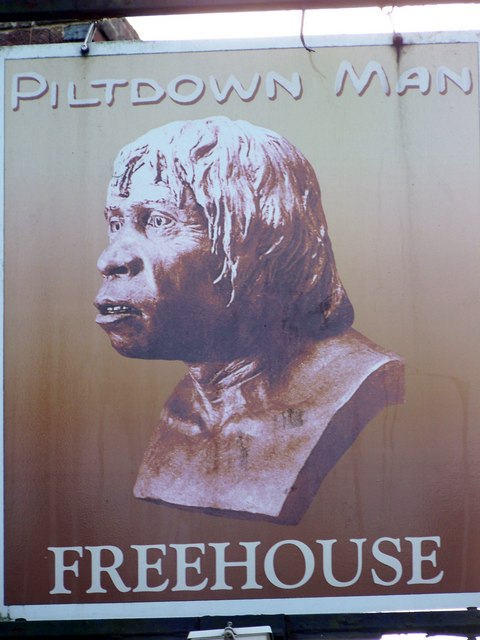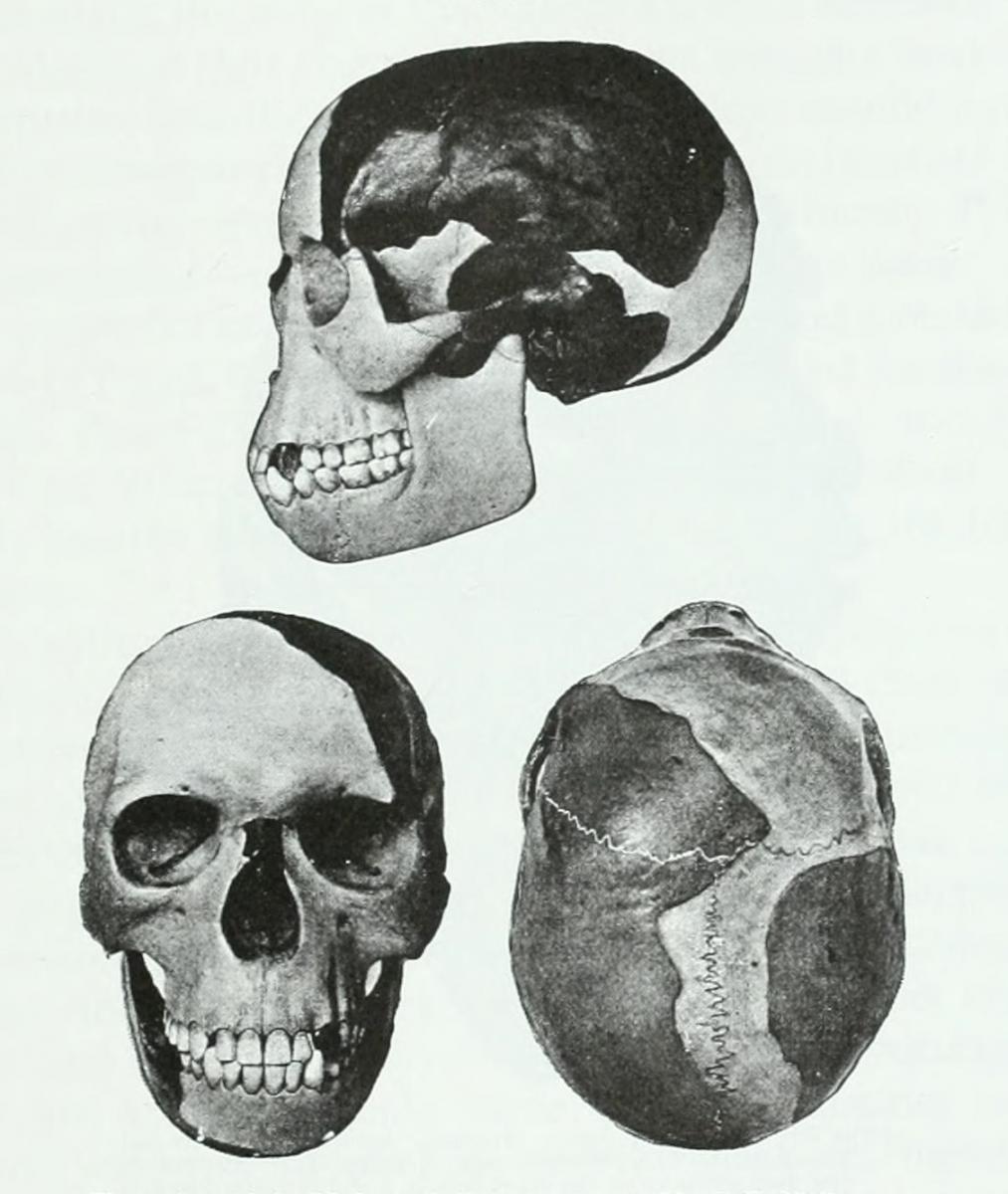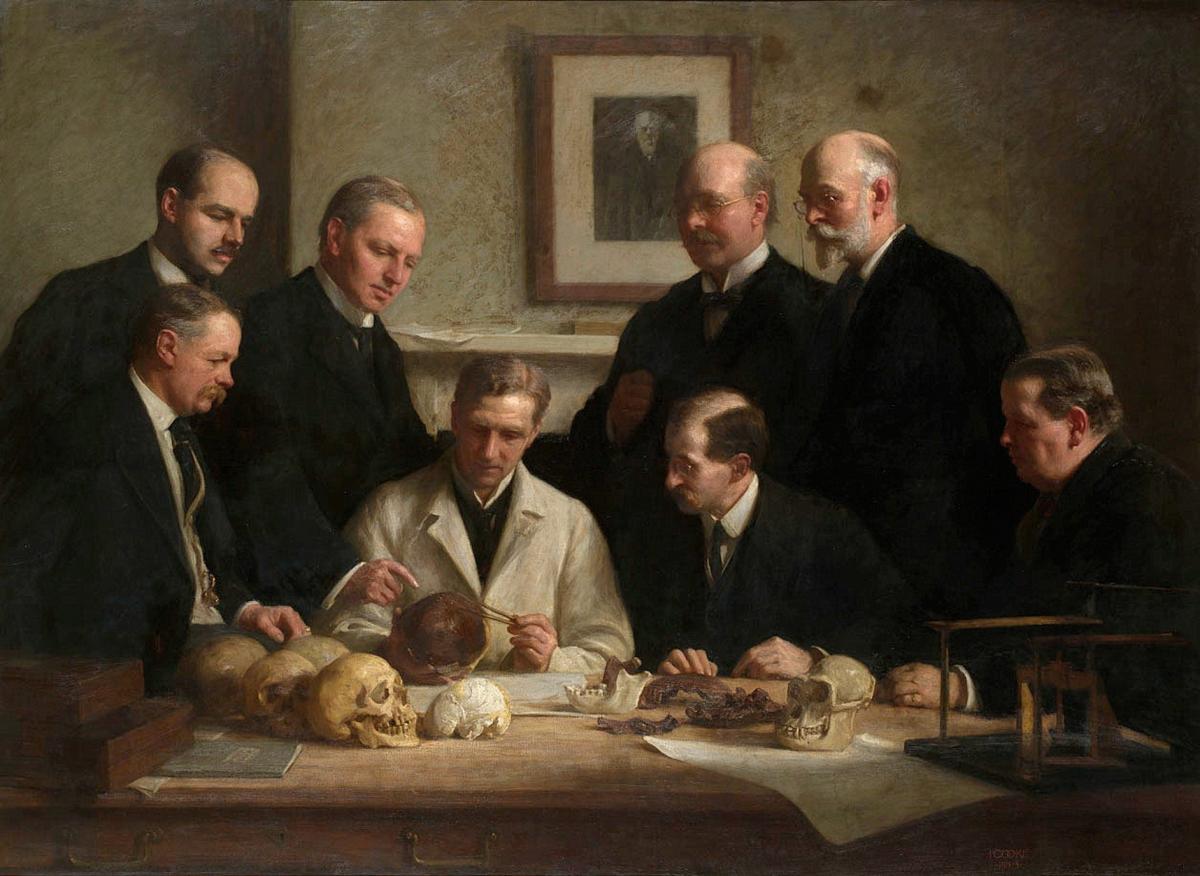
If you’re a regular reader of this blog, you know that I spend a chunk of time each year in southeast England. If you’ve ever been there, you know that it’s a simply gorgeous part of the world, with winding roads snaking through verdant forests and farmland. Dotted along the lanes are, of course, pubs, and one of those pubs, in the village of Piltdown, bore a name that always made me smile—Piltdown Man.
I never went inside, something I regret, but I always wonder if a model of the famous Piltdown skull lurked somewhere within. If you’re wondering what I’m talking about, here’s a quick summary. Charles Darwin predicted, in The Descent of Man (1871), that fossils would be found in Africa that would provide evidence that humans and primates shared a common ancestry. But the first hominin (hominins are organisms more closely related to modern humans than modern chimps) fossils were found not in Africa, but in Europe, and then Asia. At the time, many Europeans were suffering from a worldview that saw all things African as inferior, so there was initial rejection of Darwin’s prediction, and early hominin fossil finds in Europe helped to bolster that reaction. Of course, today, we know that humanity did indeed originate in Africa, but the first fossil hominins weren’t discovered on the African continent until the 1920s.
Thus, in the late nineteenth and early twentieth centuries, there was a kind of competition brewing in Europe to find new human ancestors and claim the cachet that came with them. In 1907, a 200,000–600,000-year-old specimen of what is now known as Homo heidelbergensis was found in Germany. The idea that humans originated in Germany didn’t sit well with naturalists in England—in fact, almost anything having to do with Germany didn't sit well with the English in the years just before World War I. It was with great pomp and circumstance, then that in 1912, lawyer and amateur fossil hunter Charles Dawson claimed to unearth a skull proving that a human ancestor had lived in England.

With the help of a paleontologist friend, Sir Arthur Smith Woodward, Dawson recovered parts of a large humanlike skull and more apelike jaw and teeth that he concluded belonged to a single individual that lived about 500,000 years ago. Dawson and Woodward named their find Eoanthropus dawsoni (“Dawson’s dawn man”), but it is more familiarly known, of course, by its nickname “Piltdown Man.” The discovery was celebrated with nationalistic zeal in England, as it let them claim the title of humanity’s cradle from the Germans. But before long, the celebration turned to embarrassment. In 1953 Oxford University scientists applied the new technique of fluorine dating to E. dawsoni and concluded that the remains were much younger than Dawson and Woodward had claimed. Curious, they looked a bit closer and realized that bones from a modern orangutan and modern human had been altered and dyed to make it look like they all belonged to the same specimen. There was skepticism about Piltdown Man’s authenticity before this, but now there was proof.
So whodunit? The obvious suspect was Dawson, of course, but many wondered if he acted alone or had help. Was Woodward in on it? How about Stephen Jay Gould’s pick Teilhard deChardin, a French Jesuit priest with a yen for paleontology who accompanied Dawson and Woodward on a few of their trips in search of Piltdown Man fragments? And then there’s Dawson’s friend anatomist Arthur Keith—he had the know-how to pull off a convincing fraud. Did he play a role? More exotically, could it have been an elaborate hoax perpetrated by a resentful Arthur Conan Doyle to discredit a scientific establishment that failed to share his embrace of spiritualism? All these players are, of course, dead, so the mystery has floated like the Sussex fog for decades…until now.
In another delightful example of scientists using their skills to solve mysteries (remember the tale of the Explorers Club?), paleoanthropologist Isabelle De Groote of Liverpool John Moores University led a team conducting a detailed reevaluation of Piltdown Man. In their paper, published in Royal Society Open Science, the researchers claim to have shed light on the mystery. Like previous scholars, they identify Dawson as the most likely fraudster, since he had the means and opportunity to complete the job, not to mention a record of forgery and a serious yen to join the scientific “in-crowd” (he clearly hankered to be elected to the Royal Society). Using CT scans, precise measurements, DNA analysis, and spectroscopy, the team first determined that the ape bones came from a single orangutan, while the human bones came from at least two different individuals. De Groote’s team also discovered white putty on each bone that had been used to fill in gaps and alter the bones’ shape, as well as to cover cavities filled carefully with gravel to make the bones feel heavier (as they would were they actual fossils). Consistencies in the way the bones were altered with the putty and with dye led De Groote and her team to conclude, “Throughout the whole assemblage, there’s evidence of one hand, one maker, one signature”—that is, Dawson’s.

It shouldn’t go without saying that the fraud was not actually a very good one. Indeed, many have commented on how remarkable it is that anyone ever believed that Piltdown was a real fossil. Dental putty held the teeth in place, for example, and many bones showed recent and obvious file marks. However, as Michael Price writes in Science:
"Dawson was able to fool the experts of the day by employing the same trick used by successful con artists since time immemorial: He showed them what they wanted to see. 'Dawson really played a very clever card,' De Groote says. 'With the findings coming out of Germany, and Britain wanting to be at the forefront of science, there was this sense that, ‘We must have these fossils in Britain, as well.’”
So perhaps there’s a lesson here. Indeed, De Groote concludes the summary section of her Piltdown paper with this thought: “The Piltdown hoax stands as a cautionary tale to scientists not to be led by preconceived ideas, but to use scientific integrity and rigour in the face of novel discoveries.”
Before I go, a sad postscript. A few years ago, the Piltdown Man pub changed owners and its name. Its new name? The Lamb. I suppose that it’s natural that owning a pub named after a notorious hoax might make you feel a little sheepish. Baaah.
Are you a teacher and want to tell us about an amazing free resource? Do you have an idea for a Misconception Monday or other type of post? Have a fossil to share? See some good or bad examples of science communication lately? Drop me an email or shoot me a Tweet @keeps3.

